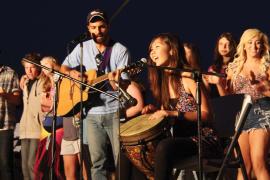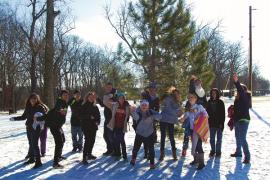Roughly thirty years ago, I packed in an urban-based career and founded a summer camp in central Ontario just north of the city of Toronto. Still, I continue to seek a fuller understanding of camp phenomena through an ongoing commitment to academic research. I was an itinerant camper and attended a variety of camps in both Canada and the U.S. In those days, summer vacation meant summer camp, and every July and August for ten consecutive years, that’s where I was. I might be riding in the Rockies or snorkeling in Lake Champlain. Sailing a boat on Georgian Bay or performing a play in the Berkshires. Camp was my opportunity for adventure at the close of every school year, and even as child, I knew that camp was a powerful and engaging place to learn.
Organized camp in the U.S. and Canada is analogous. American and Canadian children have long been spending their summers together at camps on both sides of our mutual border. National identities aside, we as a people share more commonalities than perhaps any other society divided by an international boundary. Our camp histories likewise are interconnected, and our camp philosophies are based on reciprocal principles. This also holds true for camp research. The camp experience as an educative venue was of great interest to American progressive educators in the early 20th century. American educator William Heard Kilpatrick believed camp and traditional schooling could benefit one another and was associated with early research into camps (Dimock & Hendry, 1931, p. vii).
A Research History
One of the earliest recorded research efforts into camp experience was a collaborative effort between the U.S. and Canada. In 1923, a study was undertaken at Camp Ahmek in Algonquin Park, Ontario, by Hedley Dimock and Charles Hendry of Columbia University, New York. Their findings were published in Camping and Character: A Camp Experiment in Character Education (Dimock & Hendry, 1931). Subsequently, in 1936, Taylor Statten, owner/director of Camp Ahmek, became the first president of the Canadian Camping Association, and in 1941 he was elected president of the formerly named American Camping Association. Thus the connections between American and Canadian camps have always been strong ones, and we share a common past.
Contemporary Research in Canada and the U.S.
The onset of the twenty-f irst century heralded a new era for explorations into camps as learning environments. The American Camp Association (ACA), through the generosity of the Lilly Endowment Inc., spearheaded what has become a near renaissance in camp research. The catalyst was the release in 2005 of ACA’s Directions, their initial report on youth development outcomes, part of a three-phase national study to “better understand children’s experience at camp” (ACA, 2005, p. 2). Subsequently, Inspirations (ACA, 2006a), examined the efficacy of camp experience in relation to the developmental process. Together these studies provided the blueprint for Innovations (ACA, 2006b), which advanced the design of a project for program improvement and reported on its findings.
Since that time, studies as diverse as developmental outcomes and program innovations (Garst, Browne, & Bialeschki, 2011), the benefits of intentional programming (Henderson, Scanlin, Whitaker, Thurber, Marsh, Burkhardt, & Bialeschki, 2005), and multidimensional growth through camp experience (Thurber, Scanlin, Scheuler, & Henderson, 2007) were all informed by findings from the ACA / Lilly Endowment Inc. / Youth Development Strategies, Inc. research partnerships.
Simultaneously, these research endeavors inspired scholars in Canada to begin exploring aspects of camp experience and positive youth development. One topical study explores the attitudes of new immigrant families toward summer camp (Bustamante, 2008). Directors or administrators seeking to encourage or provide programs for families of ethnic backgrounds should find this paper both interesting and informative. Other Canadian studies examine: science camps that encourage young women to consider careers in science and technology (Crombie, Walsh, & Trinneer, 2003), contextual learning and learning transfer (Fine, 2005), inclusion programs for campers with disabilities (Hutchison, Mecke, & Sharpe, 2008), and differences and similarities of campers in North America and Asia (Fine & Tuvshin, 2010).
In 2006, the Canadian Camping Association / Association des camps du Canada (CCA/ACC) embarked on a similar quest and formed a research partnership with the University of Waterloo, along with the Social Science and Humanities Research Council (SSHRC), a funding agency of the federal government. The result in 2011 was the Canadian Summer Camp Research Project (CSCRP) (Glover et al., 2011). The objective of the CSRCP was to explore and evaluate potential benefits to youth who attend Canadian summer camps. Components of the study’s camp counselor / camper observation survey were drawn from both Directions (ACA, 2005) and Inspirations (ACA, 2006a).
The CSCRP team interviewed over fifty camp directors coast to coast from across Canada. These interviews identified five common areas of development that directors perceived as beneficial to youth through participation in camp life and camp programs. These areas (see Table 1) included: social connections/integration, environmental awareness, attitudes toward physical activity, emotional intelligence, and personal development / self-confidence. Organized into six outcomes, findings indicated statistically significant increases over time for each variable.
Directions (ACA, 2005) identified similar positive gains in the areas of: positive identity (p. 6), friendship skills (p. 9), social comfort (p. 12), environmental awareness (p. 12), values (p. 14), and decision making (p. 14), which corroborates CSCRP findings in analogous areas.
Findings on gender-specific needs as reported in Inspirations (ACA, 2006a) are of particular interest as they mirror the results from the Canadian study. ACA’s conclusions state that: “Boys at camp were significantly more likely than girls to report developmentally insufficient experiences . . . (camps) need strategies that are effective with boys” (p. 16). Similarly, the CSCRP (Glover et al., 2011) stated: “While female and male campers both exhibited growth in the five areas of development (see Table 1), female campers experienced greater changes in four of the five areas . . . . Camp directors and staff may wish to consider modifying or developing some camp programs . . . to promote similar levels of development” (p. 16).
A noteworthy finding of the CSCRP was that the developmental outcomes experienced by both new campers and returning campers lacked any significant differences; both groups experienced the same amount of change. Campers did not reach a plateau where development stopped even after multiple experiences at camp. Camp, it seems, continues to offer challenges and supportive experiences that encourage development each and every time a camper attends. Also, there were overall high scores for returning campers, which suggests that the impact of camp carries over from one year to the next.
Research on a Global Scale
Individual North American studies indicate camp experience has the capacity to deliver social, physical, emotional, and spiritual benefits to youth. The equivalent findings of national studies from ACA and CCA/ACC add further authority. Yet, can the same rationale be extended to the camps of different nations and cultures? Would comparable findings on youth development emerge from “camps” or similar programs for children outside of the North American context? This was a question that prompted the comparative cross-cultural study Fostering Cosmopolitan Citizenship through Camp Experience (Fine & Tuvshin, 2010) between The Hollows Camp in Canada and the International Children’s Center Nairamdal in Mongolia.
Entering into cross-cultural research presents many challenges. Issues of distance and language aside, differing local customs and/or value systems can often be overwhelming. Additionally, one may feel ill equipped, not only because of a lack of cultural knowledge or understanding, but by an insufficient awareness of the research traditions and processes that are followed within different national contexts (Hantrais & Mangen, 1996). Methodologies designed with one culture in mind may not readily transfer to a cultural context different from the original (Oyen, 1990; Chang, 1996). However, ecological validity can be ensured by recognizing the need to design theories and instruments that are sensitive to local contexts (Ho & Cheung, 2007).
Concessions with regard to Mongolian sociocultural distinctions and camp phenomena were less demanding than originally supposed. There are over fifty children’s camps in this country of approximately 2.7 million people! Mongolia today is a democratic nation, but prior to 1991, the region was a satellite of the former Soviet Union. The Soviets had a long history of organized camping and established many thousands of youth camps throughout the USSR. This tradition of youth camp now continues within the Russian Republic as well as in many of the former Soviet territories (Pulliam, 2004).
Findings by Fine and Tuvshin (2010) support the ACA (2005) and the CCA/ACC (2011) findings as follows: Camp experience increased self-regulation, self-confidence, and independence. Additionally, habits of personal hygiene and action toward a fit and healthy lifestyle were established. Participants improved communication skills, accepted others regardless of ethnicity or social or economic standing, realized the value and practicality of teamwork, and improved skills in group planning and organization. Learning included a broader knowledge for sustaining clean air and water locally and globally, the value of contact with nature, and a commitment toward environmental responsibility.
Overall, the findings indicated that camps in both Mongolia and Canada are optimal learning environments. Most importantly, there seemed to be elements inherent to camp experience that transcend national and cultural boundaries and can effectively prepare youth for successful community interaction. This emergent data (see Table 2) went beyond the initial scope of the study and showed a correlation between the social integration that occurred at camp and elements of global citizenship.
Osler and Starkey (2003) identify the qualities of a global citizen as follows: accepting personal responsibly and recognizing the importance of civic commitment; working collaboratively to solve problems and achieve a just, peaceful, and democratic community; respecting diversity between peoples, according to gender, ethnicity, and culture; recognizing that their own worldview is shaped by personal and societal history and by cultural tradition; and respecting the cultural heritage and protecting the environment. These follow closely characteristics outlined in the seminal work of Hanvey (2001 [1976]) on the five dimensions of global awareness, as well as those advocated by the United Nations Educational, Scientific and Cultural Organization (UNESCO, 1995).
Stemming from emergent findings (see Table 2) on the correlation between social integration at camp and tenets of global citizenship (Fine & Tuvshin, 2010), the pilot study Summer Camp and the Advancement of Global Citizenship: An international study (Fine et al., 2011) was initiated. Data was collected on the measures of teamwork, problem solving, and interest in exploration drawn from ACA’s Youth Outcomes Battery (YOB). Six countries took part in this initial study: Canada, Colombia, Mongolia, Turkey, U.S., and Russia. Statistically, the mean score for global citizenship varied significantly by both length of stay at camp and by country. Lengths of stay findings are consistent with previous camp research (Roark, 2009). There was no variance based on age, sex, or years at camp, and no significant differences were found between the domains of teamwork, problem solving, or interest in exploration. Findings suggest campers internationally believe skills gained at camp contributed to their sense of global citizenship. However, further research is necessary to explore the ways countries promote global citizenship specifically and the qualities of camp experiences that are common around the world.
During the 2012 camp season, the International Camping Fellowship (ICF), in collaboration with ACA, conducted further research into aspects of education for global citizenship at camps in over twelve countries. Camper sessions designated as either control groups or intervention groups allowed for the outcomes of specific global citizenship activities included in camp programming to be measured and compared.
Global Citizens
It is encouraging to know that camp research is now taking place worldwide. Borrowing a cause and effect concept from environmental science, we as a globally interconnected species live our lives within the “butterfly effect.” Small, seemingly insignificant actions on one part of the globe can have far-reaching and increasingly magnified effects on a worldwide scale. In terms of our collective influence on one another and the planet, we can all be seen as global citizens, regardless of any national status. All youth are now in the process of globalizing. In some ways they are becoming homogeneous, but as social beings, we are all still predisposed to our cultural backgrounds and personal experiences. Living and learning at camp has the capacity to transcend national and cultural boundaries, and as such, can allow for a deeper understanding and appreciation for cultural distinctiveness in a world of global similarities.
References
American Camp Association. (2005). Directions: The youth development outcomes of the camp experience. Martinsville, IN. Retrieved from www.ACAcamps.org/research/enhance/directions
American Camp Association (2006a). Inspiration: Developmental supports and opportunities of youths’ experiences at camp. Martinsville, IN. Retrieved from www.ACAcamps.org/research/enhance/inspirations
American Camp Association (2006b). Innovations: Improving youth experiences in summer programs. Martinsville, IN. Retrieved from www.ACAcamps.org/research/enhance/innovations
Bustamante, K. (2008). Who’s nature? Exploring the link between wilderness, belonging and residential summer camp use among Canadian immigrants. Theses and dissertations. Paper 84. Retrieved from http://digitalcommons.ryerson.ca/dissertations/84
Chang, E. (1996). Cultural differences in optimism, pessimism, and coping: Predictors of subsequent adjustment in Asian American and Caucasian American college students. Journal of Counseling Psychology, 43, 113-123.
Crombie, G., Walsh, J., & Trinneer, A., (2003). Positive effects of science and technology summer camps on confidence, values and future Intentions. Canadian Journal of Counselling; Oct 2003; 37, 4; CBCA Education pg. 256-269. Retrieved from www.ccamping.org/index.php?id=41
Dimock, H., & Hendry, C. (1931). Camping and character: A camp experiment in character education. New York: Association Press.
Fine, S. (2005). Contextual learning within the residential outdoor experience: A case study of a summer camp community in Ontario. University of Toronto. Retrieved from www.ccamping.org/index.php?id=41
Fine, S., & Tuvshin, T. (2010). Fostering cosmopolitan citizenship through camp experience: Comparative research in North America and Central Asia, Presented at the 10th Biennial Research Symposium, Coalition for Education in the Outdoors, Indiana University, Bradford Woods, Indiana, Jan. 15–17, 2010. Retrieved from www.ccamping.org/index.php?id=41
Fine, S., Bialeschki, M., Browne, L., & Powell, G. (2011). Summer camp and the advancement of global citizenship: An international study. International Camping Fellowship and American Camp Association. Retrieved from www.campingfellowship.org/ICF-Web/DesktopDefault.aspx?tabid=74
Garst, B., Browne, L., & Bialeschki, M. (2011). Youth development and the camp experience. New Directions for Youth Development, Issue 130, p. 73-87, Summer 2011.
Glover, T., Chapeskie, A., Mannell, R., & Mock, S. (2011). Canadian summer camp research project. University of Waterloo. Waterloo, Ontario. Retrieved from www.ccamping.org/_customelements/uploadedResources/CSCRPReportreduced.pdf
Hantrais, L., & Mangen, S. (1996). Cross-national research methods in the social sciences. London/New York: Pinter.
Hanvey, R. (2001 [1976]). An attainable global perspective. In O’Meara and Newman (Eds.), Changing perspectives on international education (217-225). Bloomington, IN: Indiana University Press.
Henderson, K., Scanlin, M., Whitaker, L., Thurber, C., Marsh, P., Burkhardt, M., & Bialeschki, M. (2005). Intentionality and youth development through camp experiences. Presented at the 11th Canadian Congress on Leisure Research, Malaspina University-College, Nanaimo, B.C., May 17–20, 2005. Retrieved from http://lin.ca/Files/3588/CCLR11-58.pdf
Ho, S., & Cheung, M. (2007). Using the combined etic-emic approach to develop a measure of interpersonal subjective well-being in Chinese populations, In A. D. Ong and M. H. M. van Dulmen (Eds.), Oxford handbook of methods in positive psychology. Oxford: Oxford University Press.
Hutchison, P., Mecke. T., & Sharpe, E. (2008). Partners in inclusion at a residential summer camp: A case study. Therapeutic Recreation Journal, 42 (3), 181. Retrieved from www.ccamping.org/index.php?id=41
Osler, A., & Starkey, H. (2003). Learning for cosmopolitan citizenship: Theoretical debates and young people’s experiences. Educational Review, 55 (3), 243–254.
Oyen, E. (1990). The imperfection of comparisons. In E. Oyen (Ed.), Comparative methodology: Theory and practice in international social research, 1–17. London: Sage Publications.
Pulliam, L. (2004). Potatoes and soap: A Russian camp director’s dilemma. Camping Magazine, 77(6). Retrieved from www.ACAcamps.org/campmag/0411potatoes.php
Roark, M. (2009). Does the power of the camp experience differ within the length of sessions? Retrieved from www.ACAcamps.org/sites/default/files/images/research/connect/presentations/2009/Power_Camp_Experience_Differ_Length_Sessions.pdf
Thurber, C., Schuler, L., Scanlin, M., & Henderson, K. (2007). Youth development outcomes of the camp experience: Evidence for multidimensional growth. Journal of Youth and Adolescence, 36, 241–254. Retrieved from www.nccamps.org/pdf/Thurber--Youth_and_Adoles.pdf
UNESCO. (1995). Integrated framework of action on education and peace, human rights and democracy. Retrieved from www.unesco.org/education/nfsunesco/pdf/REV_74_E.PDF
Stephen Fine, PhD, is a camp researcher, owner/director of The Hollows Camp, Ontario, Canada, national research chair for the Canadian Camping Association / Association des camps du Canada, and member of the Canadian Academy of Independent Scholars, Simon Fraser University. Contact the author at [email protected].
Originally published in the September/October 2012 Camping Magazine.



